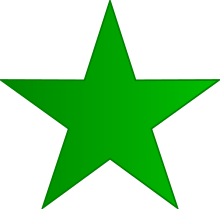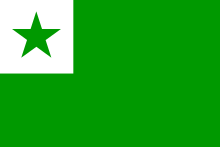Esperanto symbols
The traditional Esperanto symbol is a green, five-pointed star. It is often worn by Esperantists as a badge in the form of a small badge (often on a white background).
Emergence
Zamenhof wrote in 1911 about the creation of this symbol :
“I can't remember the creation of our green star very well. It seems to me that Mr. Geoghegan once drew my attention to the green color, and since that time I have published my writings in a green envelope. Through a brochure that I happened to have published with a green cover, he told me that it was the color of his home country, Ireland. It occurred to me that we could see this color as a symbol of Esperanto. As for the five-pointed star, it seems to me that Mr de Beaufront first printed it on his grammar. I liked that and took that as a sign. Afterwards a star with a green color appeared by association. "
The association with the green color comes about as follows: Zamenhof had his language under the pseudonym Dr. Esperanto publishes, Esperanto means hope . This name was later carried over to the language itself. Green is the color of hope and therefore of course also a symbol of Esperanto . The reform project Ido , which emerged from Esperanto, uses a six-pointed star as a modification of the Esperanto star, which is, however, no longer green.
flag
The Esperanto flag also appeared in the expansion of the green star . It consists of a green background with a white square with an Esperanto star in the upper left corner. The green of the flag is supposed to symbolize hope, the white symbolizes peace and the five-pointed star stands for the five continents . According to a recommendation of the board of the Weltesperanto Federation, UEA 3: 2: 1: 0.35 (length: height: white square: radius of the star) is given as the format of the flag. The green tone has the CMYK color values 79%, 22%, 99%, 5% (corresponds to PANTONE 363 C).
Anniversary symbol
The Esperanto egg or Esperanto jubilee symbol (Esperanto: Jubilea simbolo ), which is also green , since it was introduced by the Flemish Esperanto Federation on the 100th anniversary of the language in 1987, is also used by Esperantists as a symbol of recognition. It depicts two E placed against each other , the shape of which is reminiscent of a stylized globe.
anthem
Zamenhof's poem La Espero is considered the hymn of Esperanto , which is about world peace, unity and the ongoing blessings of a neutral language. Since the scoring was never standardized, there are now four different versions of it.

See also
Individual evidence
- ↑ UEA-Jarlibro 2006, page 273. It is unknown when the UEA board made this decision.
- ^ UEA, Rotterdam, Netherlands
- ↑ Himno Esperantista ( Memento of February 9, 2006 in the Internet Archive ) Enciklopedio de Esperanto, letters H and Ĥ, keyword Himno Esperantista .


